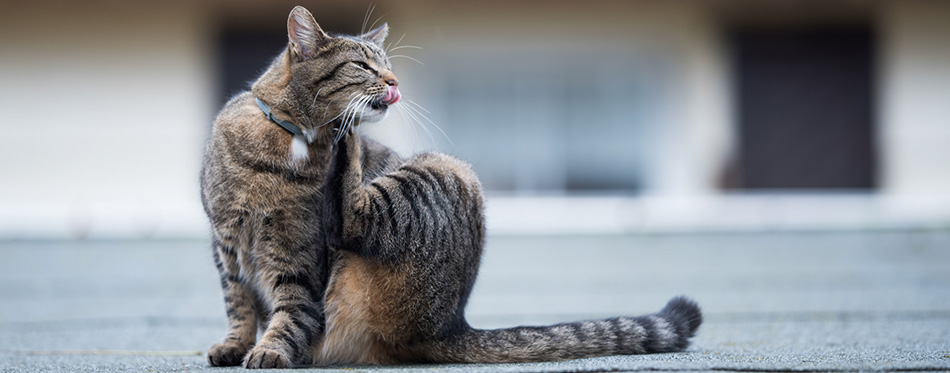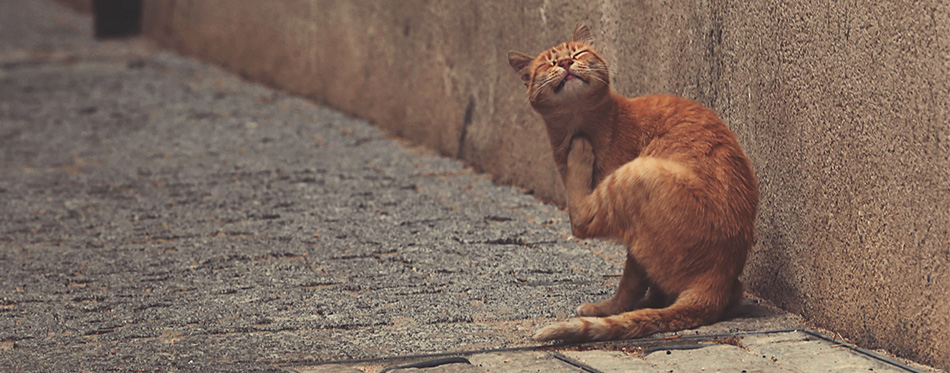Every pet owner worries when their fur-baby begins to continually itch and scratch themselves. While the reason that your cat might be itchy is usually down to fleas, in certain cases, it could be caused by lice. The scientific term for a lice infection is ‘Feline Pediculosis,’ and it’s not fun if left unchecked. Lice are parasites, and they feed on the skin of your cat. If left without treatment, the problem can become more severe and cause a number of health issues down the line. However, it’s important to note that these aren’t the same species of lice that humans can catch, and thus, your cat won’t be able to pass them onto you.
Nonetheless, they are by no means pleasant and could make an otherwise happy cat, feel miserable and annoyed. It’s a good idea to know how to identify these pesky little lice so that you can treat the problem effectively and get rid of them quickly. Lice are often prevalent in unsanitary conditions, and a lot of cats at rescue shelters are often treated for the condition when they come into the shelter.
The following guide offers you information on cat lice, how to tell the difference between fleas and lice, and then lists the symptoms of a lice infestation and the different ways that you can treat the condition.

So, What’s the Difference Between Lice and Fleas?
While fleas and lice both constitute as parasites who live off the blood of their host, they are not the same. Fleas are usually black, and you’ll often spot them jumping on your cat’s fur. Lice, on the other hand, are usually white in color, and you will usually see their eggs (much like with human lice, the ‘nits’ are often more prevalent). The white eggs will stick to your cat’s hair, quite close to their skin. Adult lice are usually flat in shape and have six legs with no wings. The species that affects cats is known as Felicola Subrostrata, and as stated above, this is not the same species that impact humans.
It has been said that fleas are usually itchier than lice. However, a lice infestation is still incredibly unpleasant, and if left untreated, can really harm your cat. Not only can the actual parasitic infection make them ill, but the constant scratching and bleeding can lead to bacterial infections, and painful open wounds. Thus, if you think your cat has a lice infection, it’s best to act swiftly. This will prevent more serious medical concerns and heal or prevent any painful symptoms (like matted hair that pulls on their skin, or open wounds from constant scratching).
Check out our guide on the best flea treatments for cats for more info.
What Are the Symptoms of a Lice Infestation?
While you might not always spot fleas or lice on your cat, you will probably be able to pick up a few tell-tale symptoms that something is wrong. If your beloved cat has a really bad lice infection, their coat may begin to look dull, scruffy, and unkempt. Because of excessive itching and scratching, parts of their coat may, in fact, fall out, and they might showcase bald spots over their body. Hair loss is usually most common in areas around the neck, shoulders, groin, and rectum. If your cat is losing hair in these areas due to persistent scratching, they certainly need some medical help.
So, the main symptoms are:
- Excessive scratching and itching
- Bald spots over their body usually targeted to specific areas
- A dull, unkempt or scruffy looking coat (that might need to be shaved off if it’s really bad)
- Possible open wounds from excessive scratching. These might need specialized ointments or even anti-biotics.
So, How Do Cats Catch Them?
Lice, much like fleas, can be easily transmitted from one cat to another. Cats can also catch lice if they come into contact with contaminated objects like blankets or bedding. Thus, if you are facing a lice infestation, it’s paramount that you also wash all the objects your cat has come into contact with on a hot cycle. This will kill the eggs and ensure that the infestation does not continue and re-infect your cat.
While you and your family won’t be able to catch your cat’s lice (because they are a different species to those that impact humans), your other pets might be at risk, so you need to tackle the problem head-on.

Treatment Options for Cats With Lice
When confronted with a lice problem, it’s always a good idea to consult your vet and to visit your local vet store to purchase the appropriate medication and treatments. Treatments vary, but usually consist of:
- A specialized shampoo, powder, or an ANIMAL SAFE insecticide spray that should only ever be administered by your vet: These work to kill the lice and might need to be used a number of times to ensure that the lice and their eggs are killed. While lice who are pulled from the hair shaft will usually die within 7-10 days, eggs take a lot longer to die. In fact, they will hatch continuously for 2-3 weeks, and thus it’s paramount that you continue your treatment plan until they are all killed. It can take 3-4 weeks for a nit to become an adult, and thus you need to be vigilant for at least a month to ensure you kill the infection. Find out more about flea shampoo for cats here.
- Continuously inspect your cat’s coat and dispose of nit eggs: During the treatment phase, it’s super important that you keep an eye on your cat’s coat and check for nits and lice. You need to check if the treatment plan is working, and if eggs are present you will know that you need to continue for a longer period of time.
- NB dispose of nit eggs safely: If you pick off any lice or nit eggs, make sure that you place them in a sealed packet and then dispose of them. You do not want them to hatch around your house and once again infect your cats. You can dislodge the eggs by using a fine-tooth nit comb. You can get these from your local pharmacy or from your vet. For a wider selection of choices, check out our flea combs for cats guide.
- Anti-biotics and ointments: If your cat has been scratching themselves excessively, they might have open wounds on their skin. Since their claws are often very sharp, they can easily damage their skin when they are constantly scratching themselves. Sometimes these cuts and wounds can become infected, and your vet might decide to prescribe them an ointment or antibiotics. If you notice that your cat’s skin has been hurt, then always consult your vet. Wounds that become infected can lead to severe medical problems if left untreated.
If Your Cat’s Fur Is Extremely Damaged or Matted
If your kitty’s coat is severely matted because of lice, it’s recommended you shave it off so your cat’s skin can breathe and grow out new, healthy fur. If possible, get this done at a professional groomer who will be able to use the tools without hurting or cutting your cat. Since grooming can be a traumatic experience for our feline friends, you will want to go to a professional who can do the job gently, and swiftly.
Once the lice have been treated, it’s incredibly important that you wash anything that your cat has been in contact with. This will include their bedding, your bedding, their collar, any grooming tools you have used, sofa covers, rugs, and cushions. You want to be totally sure that you’ve killed all the lice and any possible place where they might be lurking. There is no point in doing a brilliant treatment routine if there are still lice in your living space. A hot wash should do the trick, but to be extra safe you might want to wash bedding and other materials twice at a very high temperature.
If You Have Other Cats
If you have other cats, even those who do not seem to have symptoms of a lice infection, it’s a good idea to treat them too. If your cats are in close proximity to each other and spend their days playing or curling up in their bed, then it’s very likely they are both dealing with a lice infection. Treat them both and wash all their grooming tools, collars, and bedding, to ensure the lice are killed. If one cat is infected, it’s very probable that the rest of your pets are infected too, and there is no point in dealing with one infestation if they will be re-infected once again. Head over to our review of flea collars for cats.
If You Rescue Your Cat From a Rescue Organization
If you have adopted a cat from a rescue organization, it’s important that you do a thorough check for fleas, lice, and ticks. Since they spend a lot of time around other cats (some of whom have just come in and are strays), they might have picked up a parasite. While most rescue organizations do flea and lice dips and will check their cats, it’s a good idea to double check them, especially if you have other pets at home and don’t want an infestation on your hands. Simply do a visual check of your cat, run through their fur with a fine-tooth comb if you notice anything, and if you do suspect an infestation, get the appropriate medication from your vet. These problems can be fixed super quickly with the correct treatment plan and a can-do attitude.

Most Importantly, Don’t Let This Stress You Out! It’s Treatable
While a lice infestation can be very unpleasant and can cause a number of horrible symptoms if not properly treated, it’s not the end of the world and can be easily fixed. If you’re unsure, always consult your vet, and they can give you a definite diagnosis. With this knowledge at your disposal, you will soon be able to sort out any issue and your cat will return to being their happy and cheerful self in no time (or grumpy self, if they are that way inclined!) And remember, if you have to shave their hair off at the groomer, it will grow back in no time. Rather a slightly strange looking cat who is lice free and no longer scratching, than a cat with a painful and matted coat.
Essential tip: Chat with your vet about regular flea and lice prevention methods. This might be an ointment or liquid you place on their necks every few months, or a specialized flea and lice busting collar that aims to deter parasites and keep your pet safe. This way you don’t have to worry about who your cat comes into contact with and you can decrease their chances of infestation.
Source:
- Lice in Cats – PetMD

